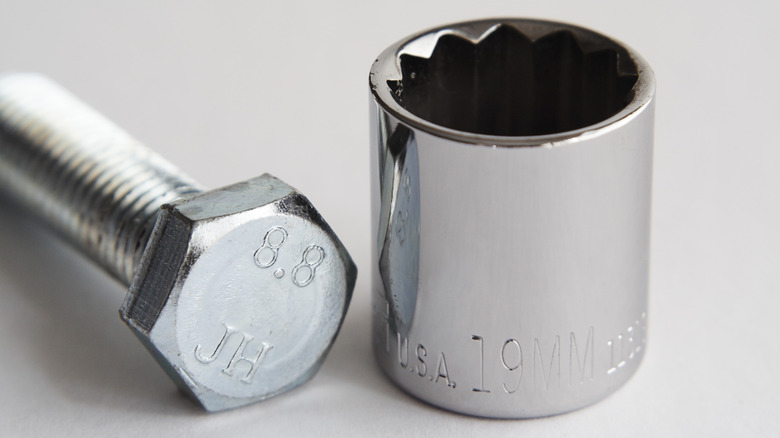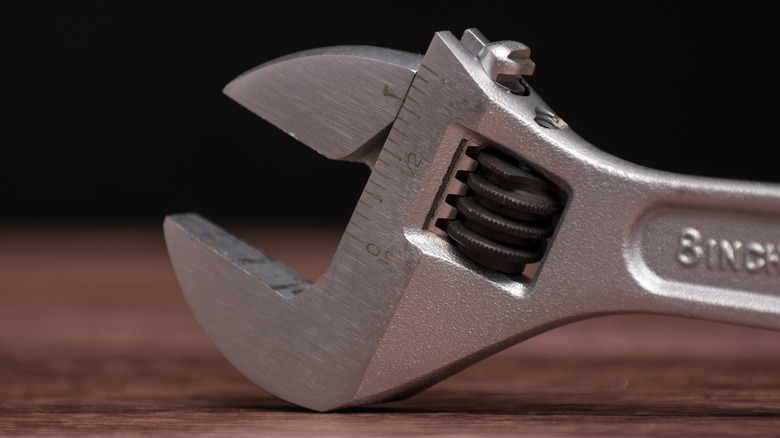Can You Use A 12-Point Socket On A 6-Point Bolt?
Working with sockets can be a bit of a challenge for those uninitiated with such tools. Trying to find the right size — assuming you don't have a universal socket, which do surprisingly work — for a specific bolt can be a tedious process, but it gets even more so when taking into account the different types of sockets out there. Hex head, or six-point bolts and nuts, are the most common, so many sockets are designed with this six-point setup in mind. However, it's entirely possible that you could have to use a 12-point socket in a pinch, but will this actually work with a six-point bolt?
Conveniently, for those without a six-point socket at the ready, a 12-point socket will function just fine when paired with a six-point nut or bolt. Due to the geometry of these sockets, they can fit all six points of a socket just fine. Not to mention, with a 12-point socket, you're able to enjoy some of the added benefits that come with it. These sockets can work with a range of bolt head types, and they're great to have when working with your socket wrench in tight or low-visibility areas. The added points require less maneuvering to get the orientation right, ensuring it can secure to the bolt faster and easier than a six-point socket might.
With that said, a 12-point socket isn't necessarily better than a six-point one for such a bolt. In fact, it can actively make your job more difficult if relied upon in the wrong situation.
12-point sockets aren't ideal for six-point bolts all the time
When comparing 12 and six-point sockets, it's undeniable that the two look distinctly different. The six-point socket is specifically designed for the equivalent nuts and bolts, taking on their exact shape for easy use. Meanwhile, the 12-point socket is more circular, with less defined sides and smaller grip points. As mentioned, this design is great for maneuverability, since it doesn't have to be as precisely placed onto the bolt head to connect. In terms of grip strength, though, a 12-point socket is lacking when paired with a six-point bolt — much to the detriment of the job you could be working on with the two.
A lot can go wrong when trying to use a 12-point socket on a six-point bolt. For one, if the bolt itself is too tight, it won't budge no matter how hard you crank. With its less effective grip, the socket could basically spin around on the bolt head without moving it. In turn, this can swiftly strip down both the socket and the bolt head, making removal more difficult than it already was. On top of that, if you keep trying to force a 12-point socket to move a six-point bolt, the socket is more likely to slip off, potentially damaging you or your socket wrench. Thus, it's best to only bring the two together when you know you can get the bolt unscrewed without damaging anything.
If you don't have a six-point socket and aren't comfortable using or can't effectively use a 12-point socket to remove a nut or bolt, don't panic. There are some alternatives to try out.
12-point socket alternatives for six-point bolt removal
If you need a six-point nut or bolt removed — especially if it's stuck in place — there are better ways to go than trying and failing with a 12-point socket. A six-point socket is the best option, but if you can't get hold of one, you can try out some other tools. First, try a set of pliers or an adjustable wrench. Just secure the tool to the head and use your might to crank it out of place. If it won't budge, you can try a penetrating oil, which is better at loosening parts than WD-40, to get the stuck or rusted nuts and bolts moving. Hopefully, it will free up the hardware, allowing it to be removed with ease.
There's another effective way to go, though it will damage the bolt, so disregard this if you need it intact. Using a grinder, you can shave the head into a square, making it easier to get a wrench around it and, ideally, get it to turn. Sticking with the grinder idea, you could always just cut the head of the bolt off entirely and go about one of the multiple ways to remove a broken bolt. If you're specifically dealing with a stuck nut, a nut splitter should be able to do the trick. Slide it over the nut, screw the splitter on until you hear a pop. Remove the splitter and the broken nut, and you should be able to remove your stuck bolt.
The only thing worse than a stuck bolt is not having the right tools to remove it. As handy as it is in some scenarios, with an especially stubborn six-point bolt, a 12-point socket likely won't do the trick.


